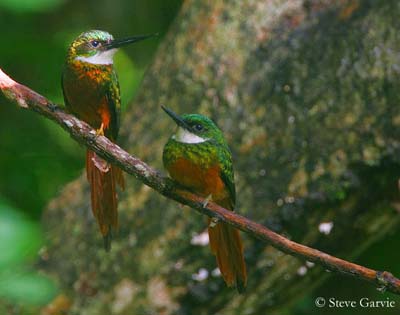
Rufous-tailed Jacamar
Galbula ruficauda
Piciforme Order – Galbulidae Family
BIOMETRICS :
Length: 22-25 cm ; Weight: 18-28 g
DESCRIPTION:
Rufous-tailed Jacamar is a brightly coloured bird.
Adult male has shining metallic coppery-green plumage on upperparts. On the wings, the primaries are blackish. The long, graduated tail shows two longer rectrices. The other tail feathers are cinnamon.
On the underparts, chin and throat are white. Breast shows a broad metallic coppery-green band. Belly, vent and undertail are rufous-chestnut. Underwing coverts are cinnamon and flight feathers are dark grey.
Female resembles male, but she has cinnamon-buff chin and throat. She is slightly paler and duller than male.
Juvenile has shorter bill and tail than adults. The upperparts are duller, and the breast band is less regular and broader than in adults.

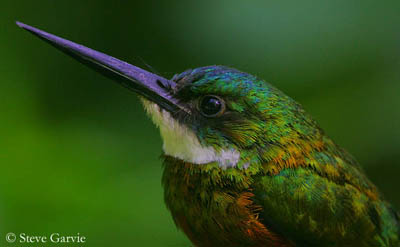
Head is metallic green. The long, sharp black bill is about 4 to 5 cm length. Eyes are dark brown with bare greyish eye-rings and lores. Legs and feet are yellowish-brown.
We find six subspecies:
G.r. melanogenia; G.r. pallens; G.r. brevirostris; G.r. ruficauda; G.r. rufoviridis; G.r. heterogyna.
They differ in varying amount of colours in plumage and bill size.
VOICE: SOUNDS BY XENO-CANTO
Rufous-tailed Jacamar’s call is a sharp, thin “peeup” repeated 3 to 10 times by both sexes. It also utters a rapid trill.
Song is a rapid phrase of several notes ending in trill “peeo-peeo-peea-pee-pee-pe-pe-pe-pe-pe-illllll”. This prolonged song uttered by the male may vary, including melodious or buzzy parts, twittering, ascending trills and low “pee-pee-pee”.
HABITAT:
Rufous-tailed Jacamar frequents several kinds of habitats, such as shrubby forest edges, gallery forests, second-growth thickets, streams and rivers’ banks, marshes and savannahs with scattered trees.
It may be seen from lowlands up to 900 metres of elevation, rarely up to 1300 metres.
RANGE:
Rufous-tailed Jacamar is widespread on a large range, from southern Mexico to northern Argentina, including Mexico, Costa Rica, Ecuador, Colombia, Brazil, Argentina, and Trinidad and Tobago.
BEHAVIOUR:
Rufous-tailed Jacamar feeds mainly on insects caught on the wing, by flycatching, aerial sallies or pursuit in the air. When the prey is caught, the bird beats it against a branch or other hard surface, in order to kill it, and to remove the more resistant parts of the body and the wings. Then, the prey is swallowed whole. This behaviour is observed only for relatively large preys. Rufous-tailed Jacamar hunts from an exposed perch.
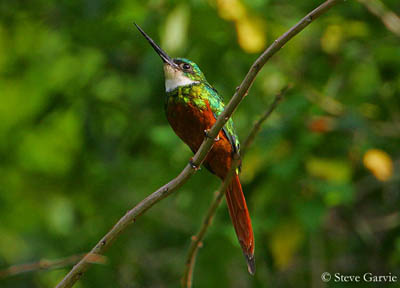
It is highly sedentary, only performing some short dispersal, but it does not migrate.
Rufous-tailed Jacamar is very active, often seen in pairs in shrubs, hunting for insects.
During breeding season, the male performs regular courtship-feeding. It catches insects for its mate, offered without wings or hard parts. Both mates perch close to each other while the male bobs its head upwards, downwards and sideways, and swings the tail up and down. At this moment, the male utters low notes and female gives trills. At other moment, always perched side to side, both mates fan their tails and bow together.
FLIGHT:
Rufous-tailed Jacamar has swift flight, fairly brief when pursuing preys. If the bird needs to fly long distances, for escaping a danger or between two feeding areas, it flies with bursts of rapid wing beats and glides. At this moment, the flight seems to be undulating.
REPRODUCTION:
Breeding season varies according to the range.
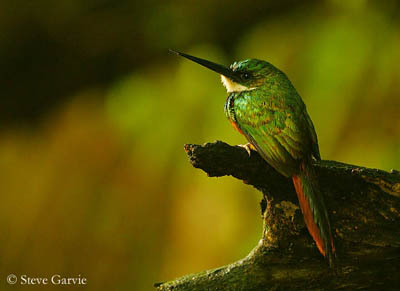
Rufous-tailed Jacamar nests in burrows excavated by both sexes. It is situated in sandy banks or termitary, and even in higher roots of fallen trees, from the ground up to three metres high.
The burrow is usually straight, and the nest-chamber is sometimes partially visible. If there is any obstruction such as roots, the angle may deviate as sideway or downwards. The entrance is usually rectangular with vertical sides. The burrow is about 20 to 50 cm deep, with terminal cavity for the nest-chamber which is unlined.
Female lays 2 to 4 white eggs. Incubation lasts about 19 to 23 days, shared by both parents, and female mainly at night. Calls and displays occur at each change of incubating bird.
At hatching, the chicks are covered with long whitish down. They are fed by both adults with insects caught around the nest-site, within 50 metres from the burrow.
Young fledge about 20 to 26 days after hatching. Adults and youngs roost at night in the burrow after fledging, and during about 8 weeks.
This species produces one brood per season, but probably two.
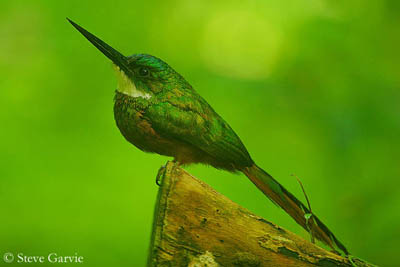
DIET:
Rufous-tailed Jacamar feeds mainly on insects caught by flycatching and sallies. The diet includes a wide variety of insects, even wasps.
The bird perches 1 to 3 metres above the ground on relatively exposed perch. When the prey is caught, it beats it several times against the branch, in order to kill it and to remove the indigestible parts before swallowing.
PROTECTION / THREATS / STATUS:
Rufous-tailed Jacamar is common and widespread in its range. The major threats for this species are deforestation and habitat loss.
Rufous-tailed Jacamar populations are not threatened at this moment.
Fr: Jacamar à queue rousse
All : Rotschwanz-Glanzvogel
Esp : Jacamará Colirrufo
Ital : Jacamar codaruggine
Nd : Roodstaart-glansvogel
Russe : Краснохвостая якамара
Photographs by Steve Garvie
His website:
RAINBIRDER Photo galleries
Text by Nicole Bouglouan
Sources:
HANDBOOK OF THE BIRDS OF THE WORLD Vol 5 by Josep del Hoyo-Andrew Elliott-Jordi Sargatal - Lynx Edicions - ISBN: 8487334253
Arthur Grosset's Birds (Arthur Grosset)
Wikipedia (Wikipedia, The Free Encyclopedia)